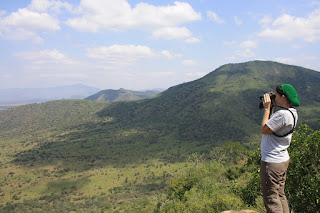 |
| Open grasslands with zebra, giraffes and waterbuck grazing. |
It took us about a year and a half for
our first visit to Arusha National Park, but after discovering it (along with acquiring a vehicle) it's easily become the most accessible and affordable national park to explore.
Although it has nowhere near the amount of big game the other big national parks have, it has a variety of ecological zones, as well as less visitors and a more intimate feel. Certainly not the iconic plains of Serengeti; rather the park is in the shadow of Mt. Meru (4655m/15,275 ft) on the western border of the park with Ngurdoto Crater in the east. The incredible variety of habitats include montane rainforest, open crater lakes, and grasslands.
The park entrance is only about an hour drive from our house in Moshi. Seeing as the fees are still relatively high (costs us about $50 for the both of us) we got there at 7am (park opens at 6:30). Unfortunately for us, it is still the tail end of the rainy season and the park is quite wet in general. It was a misty morning and we decided to explore the Ngurdoto Crater in the east end of the park. We hadn't been there before and we figured if it was rainy and foggy, we might as well have a bit of cover in the forest.
The montane rainforest is fantastic and the muddy and steep roads gave us time to test our new vehicle. Birds and monkeys called in the distance as the fog and rain fell on the trees and rocks coated in moss and lichen. We went up to a viewpoint and met a lonely park ranger. He explained you can typically get beautiful views of the crater, akin to Ngorogoro Crater but smaller. The weather was very chilly and we enjoyed the non-existent view, though still beautiful landscape and tranquil setting.
 |
| Driving up around Ngurdoto crater. |
 |
| Seems to be quite wet this time of the year. |
 |
| Misty and rainy montane forests are some of my favorite habitats. |
After spending the morning in the forest, we spent the rest of the day driving around and hanging out at the lakes. Known as the Momella Lakes, there are seven shallow alkaline crater lakes (thee exception is Lake Longil being freshwater). Being alkaline, they are very salty and animals don't use them for drinking, rather they use them for the micro-organisms and algae that adapt to each lakes varying mineral content.
There also happened to be thousands of flamingos which was quite a sight to see. The weather had cleared up in the afternoon so the wildlife was out. Since the grasses are in full growth and the animals are fat, they seemed to have more time on their hands. We saw waterbuck, giraffes and zebras all fighting, likely for breeding rights or social status. The giraffes were particularly incredible to watch as they swung their heads into their rival's body in hopes of inflicting damage with their stubby horns.
The afternoon was quite leisurely as we toured around the lakes. There is a circular road around them and we realized we needed to come back and spend a whole day just on the lakes. We ended up leaving the park around 5:30 and we've already made plans for our next Arusha National Park excursion!
 |
| Interesting geography by the Momella Lakes. |
 |
| Driving up to Big Momella Lake revealed more than a few flamingos. |
 |
| Tulusia Lake with flamingos. |
 |
| Tulusia Lake from another angle. |
 |
| Lekandiro Lake. The road was extremely overgrown and the absence of most wildlife explained why. |
|
 |
| Ana checking out some Little Grebes at the infrequently visited Lekandiro Lake. |
 |
| Roads in the park. |
 |
| Tons of flamingos. |
 |
| Mt. Kilimanjaro with Momella Lakes and flamingos. |
 |
| Mt. Meru in clouds with Momella Lakes in front. |
 |
| Mt. Meru covered in clouds. |
 |
| Nice landscape. |






































